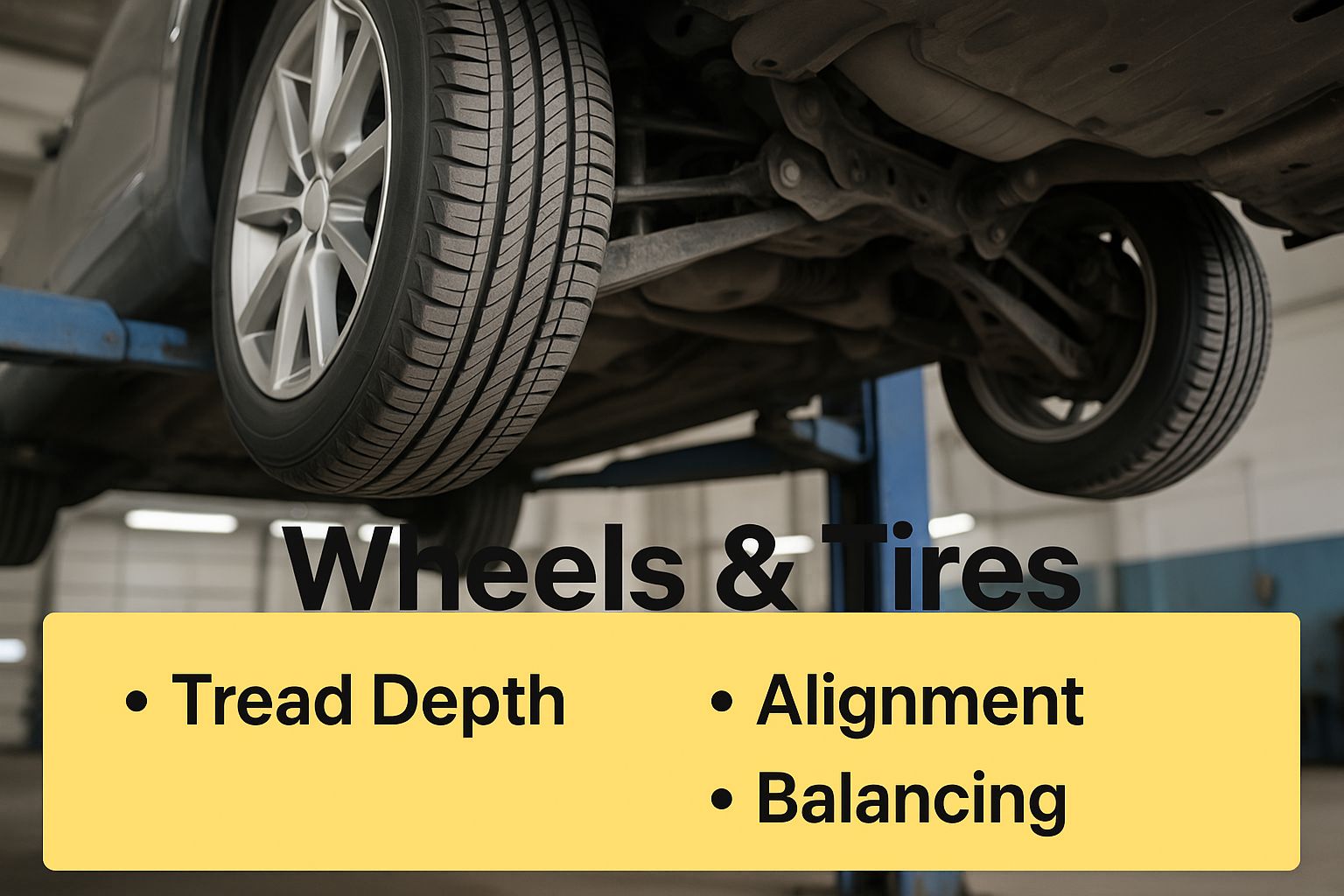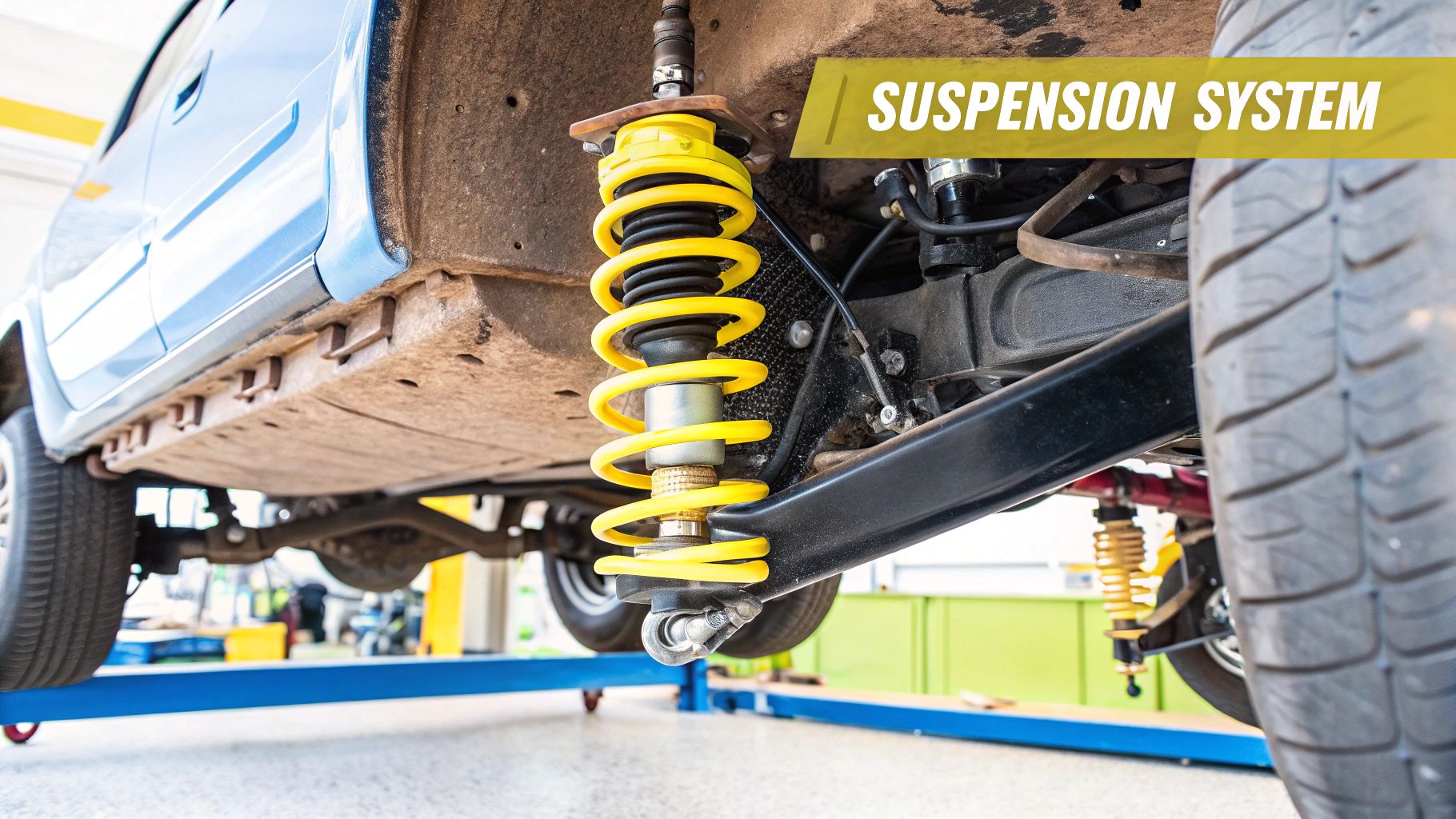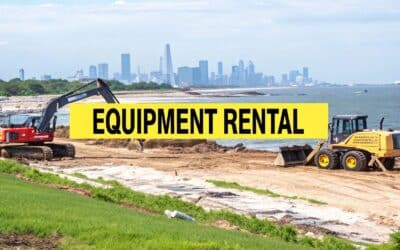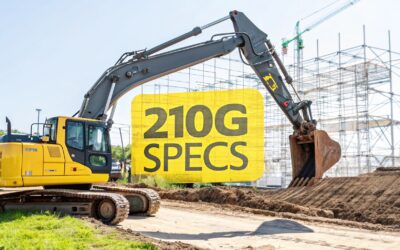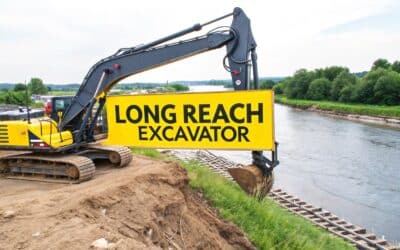When you look at a piece of heavy equipment, your eyes might be drawn to the massive arm, the powerful engine, or the operator's cab. But the real unsung hero, the foundation of everything the machine does, is the undercarriage. It is the entire system that gives an excavator its stability, mobility, and raw power to navigate the toughest job sites.
This system is built from several key parts working in harmony: the track chains, rollers, idlers, sprockets, and track shoes. For decision-makers in demanding industries like dredging, pipeline installation, and environmental cleanup, understanding these components is crucial for project success.
More Than Just Steel: Your Foundation for Success
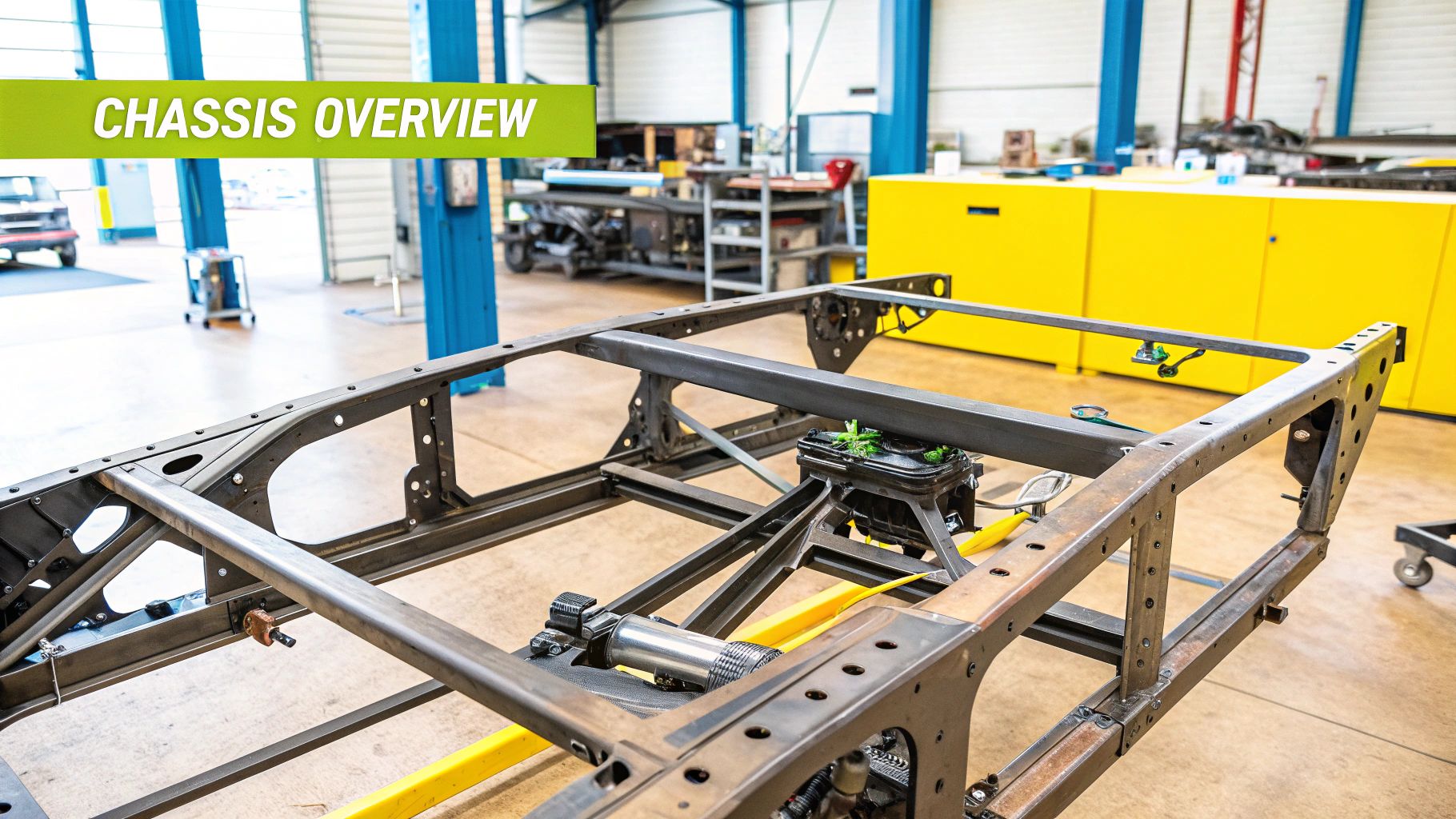
The undercarriage is where the steel meets the ground. For any machine, it’s critical. But for specialized equipment like amphibious excavators working in swamps, wetlands, or dredging sites, the undercarriage is the single most important factor determining whether a project succeeds or fails.
A solid, well-maintained undercarriage isn't just a "nice-to-have"; it directly impacts your bottom line in very real ways.
- Boosted Efficiency: A smooth-running system translates to less drag, which means lower fuel consumption and more work done every hour.
- Unshakeable Safety: Stability is everything. A robust undercarriage prevents dangerous tipping incidents and gives your operators the confidence to work safely on soft or uneven ground.
- Improved Profitability: It's simple math. Less downtime for repairs plus longer-lasting components equals lower ownership costs and more time generating revenue.
The numbers back this up. The global market for undercarriage components is valued in the billions, highlighting its importance across construction, mining, and environmental work. The projected growth in this market shows just how much the industry relies on durable, high-performance machinery.
At Wilco Manufacturing, we have deep expertise in these systems. We know that a reliable undercarriage is the backbone of any successful operation, especially in the challenging environments our clients work in. That’s why we’ve put together this guide, to pull back the curtain and break down each component.
When you understand how these parts of the undercarriage work together, you're empowered to make smarter maintenance decisions, solve tough job site problems, and get the most out of your equipment's lifespan. It's a level of expertise our team is built on, as you can see in our company story.
Key Undercarriage Components at a Glance
Before we dive deep into each part, here’s a quick-reference table to get you started. Think of this as your cheat sheet for understanding what each component does at a high level.
| Component | Primary Function |
|---|---|
| Track Chains | The backbone of the track system, linking all components together. |
| Track Rollers | Support the machine's weight and guide the track chain. |
| Idlers | Guide the track chain at the front and provide a way to adjust track tension. |
| Sprockets | The gear that engages with the track chain to drive the machine forward or backward. |
| Track Shoes (Pads) | The "footprint" of the machine, providing traction and flotation. |
This table gives you the basics, but the real magic is in how these parts interact. Now, let's explore each one in detail.
Track Chains and Shoes: The Backbone of Mobility
When you look at an excavator's undercarriage, the most prominent parts are the track chains and track shoes. Think of them as the machine's skeleton and muscle for getting around. They have to work together perfectly to provide both movement and solid traction.
The track chain itself is a marvel of engineering, a series of hardened steel links, pins, and bushings all connected in a flexible loop. It operates like a giant bicycle chain, but one built to handle crushing forces and the constant grind of dirt, rock, and mud.
Bolted right onto that chain are the track shoes, which you might also hear called grousers. These are the parts that actually touch the ground. They function like the tread on a heavy-duty tire, giving the machine the bite it needs to push, pull, and maneuver tons of steel with precision. The design of these shoes is one of the most important decisions you can make for an undercarriage.
Choosing the Right Shoe for the Job
You wouldn't wear hiking boots to the beach, and the same principle applies here. Matching the track shoe to the job site is absolutely critical. For industries like land reclamation or pipeline installation, the wrong choice can lead to poor performance, unnecessary ground damage, and accelerated wear on the entire undercarriage.
- Single or Double Grouser Shoes: These are the aggressive option. With one or two tall, sharp bars (grousers), they are designed to dig deep into hard, rocky ground for maximum grip. This makes them ideal for quarry work, but less suitable for soft soil.
- Triple Grouser Shoes: This is the go-to, all-around performer and the standard for most excavators, especially amphibious models. The three shorter grousers provide a fantastic balance of traction and maneuverability without tearing up the ground.
When your work takes you into wetlands, swamps, or dredging sites, this choice becomes even more crucial.
The name of the game for amphibious equipment is flotation. Wider, triple grouser shoes are designed to spread the machine’s massive weight across a much larger area. This simple principle is what keeps the excavator from sinking into muck and allows it to work where standard machines would be hopelessly stuck.
This image really breaks down how the ground-engaging parts like track shoes connect with the rest of the system.
You can see how all these individual components must come together precisely to create a system that can both support the machine and move it effectively.
Maintenance and Component Life
It’s no surprise that track chains and shoes are high-wear items. They live a hard life of constant friction and impact. Over time, the pins and bushings inside the chain links wear down, causing the chain to "stretch." This is not a true stretch, but an increase in pitch that creates a sloppy fit with the sprocket, which in turn accelerates wear on both parts.
Regular inspections are your best defense against small problems turning into large, expensive ones. A well-maintained set of tracks keeps your machine running efficiently, helps you save on fuel, and ensures you stay productive. For amphibious machines working in uniquely abrasive or corrosive environments like saltwater marshes, investing in top-quality replacement parts is essential. You can find a full lineup of components built for these demanding conditions by exploring our Hydratrek parts.
Rollers: Supporting and Guiding the Load
If the track chains are the backbone of the undercarriage, then the rollers are the unsung heroes carrying the entire operation. These rugged components are tasked with distributing the machine's immense weight and ensuring the track chain moves as it should. Without them, the whole system would grind to a halt.
Rollers on heavy equipment are some of the most critical parts of an undercarriage, and they come in two main types: track rollers and carrier rollers.
You'll find the track rollers, sometimes called bottom rollers, lined up along the bottom of the track frame. Their main job is to bear the machine's full weight, transferring it down through the track shoes and onto the ground. This constant, heavy load means they must be incredibly tough to handle the pressure and impact of daily work.
Up top, you have the carrier rollers (or top rollers). They serve a different but equally vital purpose: supporting the weight of the track chain as it returns along the top of the frame. This prevents the chain from sagging and ensures it feeds smoothly back to the sprocket.
The Critical Role of Roller Maintenance
When it comes to rollers, proper lubrication and regular inspections are non-negotiable. They are constantly moving under extreme pressure, and even a small issue can snowball into a major failure.
A single seized roller can set off a chain reaction of damage across the entire undercarriage. It puts immense stress on its neighbors, the track chain, and the frame, often leading to a cascade of failures that result in costly downtime. This is a common challenge in pipeline construction, where equipment operates under continuous, heavy loads.
Keeping a close eye on your rollers is one of the best preventative maintenance tactics you can adopt. Uneven wear on your rollers is often the first red flag for a track frame alignment problem, giving you a chance to fix it before it causes catastrophic damage.
For specialized machines like an amphibious excavator, the demands are even greater. The constant exposure to water, mud, and grit puts enormous strain on every single component.
Key Inspection Points for Rollers
To get the most life out of your undercarriage, make these quick checks part of your daily walk-around:
- Look for Leaks: Check the roller seals for any sign of oil. A leak means a seal has failed, and bearing failure isn't far behind.
- Check for Flat Spots: Uneven wear or distinct flat spots are a dead giveaway that a roller has seized. Instead of turning, it's being dragged, creating intense friction and heat.
- Listen for Abnormal Noises: Squealing or grinding sounds during operation almost always point to internal bearing damage that needs immediate attention.
Catching these problems early allows you to schedule repairs on your terms, not in the middle of a critical job. This proactive mindset is key to managing the true operational costs of heavy machinery.
Idlers and Sprockets: The Power and Guidance Duo
At opposite ends of the track frame, you’ll find the idler and the sprocket. Think of them as the tag team responsible for steering and pushing the entire machine. They might look simple, but they handle the immense forces of guidance and propulsion, making them two of the most critical parts of any undercarriage.
The sprocket is the muscle. It’s a heavy-duty toothed gear that gets its power directly from the final drive motor. As it turns, its teeth grab the track chain's bushings and pull the machine forward or backward. This is where the engine’s power meets the ground, translating pure torque into unstoppable movement.
On the other end, the idler wheel is the guide. It doesn't drive the track, but it steers the chain at the front of the frame. Just as crucially, it’s also home to the track adjuster mechanism, the system that controls track tension, a single factor that can make or break the lifespan of your entire undercarriage.
The Fine Line of Track Tension
Getting track tension right is a constant balancing act. If a track is too tight, you’re creating a massive amount of friction and strain on every moving part. This kind of pressure will drastically speed up wear on pins, bushings, rollers, and even the sprockets themselves.
On the flip side, a track that's too loose is just as bad. It can cause the chain to jump off the idler or sprocket, a frustrating event known as de-tracking. This not only grinds your operation to a halt but can also cause serious damage to the track frame and other components.
For operators doing work like dredging or land reclamation, managing track tension isn't just a suggestion, it's a critical skill. The undercarriage constantly packs with mud, sand, and debris, which has the same effect as tightening the track and putting everything under incredible stress.
Proper tension is the single most important maintenance adjustment an operator can control. Getting it right minimizes wear, reduces fuel consumption, and prevents catastrophic failures that lead to costly downtime and repairs.
The importance of these parts is reflected in the global market. The demand for durable undercarriage components is massive, driven by the simple fact that heavy machinery in tough environments chews through parts, creating a constant need for reliable idlers and sprockets to keep projects running.
At Wilco, we know that your machine is only as good as its weakest component. That's why our amphibious hydraulic undercarriages are built with exceptionally robust parts designed to handle the absolute worst conditions. We focus on superior materials and precision engineering to make sure every idler, sprocket, and roller gives you the reliability your work demands.
A Practical Approach to Undercarriage Maintenance
Knowing the parts of an undercarriage is one thing, but keeping them running is what really protects your investment. When you consider that undercarriage wear can account for up to 50% of a machine's total maintenance budget, a solid care strategy isn't just good practice, it's a financial imperative.
It all starts with simple, daily habits that any operator can build into their routine. A quick walk-around before starting a shift to check for loose bolts, leaks, or busted track shoes can stop a small problem from turning into a big one. At the end of the day, cleaning out packed-in mud, rocks, and debris is probably the single best thing you can do to reduce wear. That packed material acts like sandpaper, grinding away at every moving part and putting a ton of stress on the whole system.
Building a Simple Maintenance Cadence
A structured maintenance plan is your best defense against catastrophic failures. When you break tasks down into daily, weekly, and monthly checks, you create a system that cuts down on surprise downtime and squeezes every last hour of life out of your equipment.
This disciplined approach means your machine is always ready to go, which is critical in tough jobs like environmental cleanup or land reclamation where reliability is non-negotiable.
This focus on maintenance reflects a broader industry trend. According to a report from IMARC Group, the global market for undercarriage systems, which includes all the parts we've covered, is projected to grow significantly, thanks to massive infrastructure and mining projects. This growth highlights just how much the industry is banking on durability and performance, putting maintenance front and center.
The Power of a Preventative Schedule
Setting up a maintenance routine might seem like a lot of work, but it doesn't have to be complicated. Focusing on a few high-impact tasks can make a world of difference. To get you started, here’s a straightforward schedule that covers the essentials.
| Frequency | Maintenance Task | Purpose |
|---|---|---|
| Daily | Visual Walk-Around | Your first line of defense. Look for obvious problems like loose hardware, leaks, or cracks. |
| Daily | Clean Out Debris | Remove packed mud, rocks, and gunk from the track frame, rollers, and idlers to prevent abrasive wear. |
| Weekly | Check Track Tension | Measure track sag and adjust it based on your manufacturer’s specs. Proper tension is crucial for all components. |
| Monthly | Measure Key Wear Points | Use calipers to track wear on bushings, grousers, and rollers. This helps you predict when to order replacements. |
Following a simple but consistent schedule like this turns your equipment into a reliable asset, ready to tackle any project with maximum uptime and efficiency. It’s the smartest way to manage the long-term health of your machine.
How Do You Keep Your Undercarriage in Top Shape? Partner with the Experts.
A solid undercarriage is the bedrock of your entire operation. It's not just a collection of parts; it's a complete system where every component, from the track shoes gripping the earth to the sprockets driving them forward, plays a critical role. Understanding what each part does is the first step, but ensuring they all work together in the demanding conditions of a real-world job site requires a different level of expertise.
That’s where we come in. At Wilco Manufacturing, we live and breathe these systems, especially for amphibious equipment. We are not just selling parts off a shelf; we're your project partner, invested in seeing your job succeed. Our team understands that sites for pipeline work or environmental remediation throw challenges at machinery that standard gear just can't handle. That's why we build our undercarriages to take the abuse of abrasive mud, corrosive water, and the relentless stress of amphibious work.
Think about it: for dredging, land reclamation, or wetland construction, a generic, off-the-shelf undercarriage is a recipe for disaster. It almost always leads to early part failure and the kind of expensive downtime that can derail a project. Working with a specialist ensures your machine is built for the job it's doing, which means better performance and a much longer life for your components.
Whether you're in the market for a custom-built amphibious undercarriage, need top-notch replacement parts, or just want solid advice on maintenance, we're here to help. Our goal is to deliver solutions that not only get the job done but also protect your investment.
Get in touch with us to talk through your project. Let's figure out how Wilco's specialized experience can make your fleet more reliable and keep your machines running longer.
Common Questions About Undercarriage Parts
Even after breaking down all the components, you may still have questions. Here are some of the most frequent ones from operators and fleet managers working in the field.
What’s the Number One Killer of an Undercarriage?
Hands down, it's improper track tension. I've seen it cause more premature wear than almost anything else.
A track that is cranked down too tight puts a constant, massive strain on everything. Every pin, bushing, roller, and sprocket is grinding away under that immense friction. On the flip side, a track that is too loose is just as bad. It can sag and slip right off the idlers, a situation we call de-tracking. That means instant downtime and a high risk of damaging other components.
Your best defense? Check and adjust your track tension regularly. Make it a habit and stick to the manufacturer's specs for the ground you're working on.
How Often Should I Clean the Undercarriage?
If you’re working in muck, like dredging sites, swamps, or sandy riverbeds, the answer is daily. No exceptions.
All that packed-in mud, sand, and grit basically turns into a grinding paste. It works its way into every moving part, acting like sandpaper on your rollers, idlers, and track chains. This gunk also adds a surprising amount of weight, stressing the drive system. In the winter, it can freeze solid, seizing components and turning a small problem into a big one.
A good power wash at the end of every shift stops that abrasive gunk from doing damage overnight and makes your morning inspection much easier and more effective.
Can I Mix Parts from Different Brands?
I know it can be tempting to mix and match parts to save a few dollars, but it's a bad idea in the long run. Different manufacturers have their own specs for things like steel hardness, heat treatment, and dimensional tolerances.
Even tiny differences in size or material can lead to an improper fit. This creates uneven wear patterns, causing some parts to fail much faster than they should. For the best performance and longest life, stick with a matched system from a single, reputable supplier. That’s how you ensure every part works together in harmony.
When Is It Time to Replace the Whole Undercarriage?
This is a judgment call, but it really comes down to wear patterns and simple math. If you had a specific failure, say, one bad roller, it makes sense to just replace that single part.
But if you look underneath and see that your track chains are worn, your sprocket teeth are looking sharp, and several rollers are on their last legs, you're better off doing a complete overhaul. A full replacement ensures all the new components wear in together at the same rate. It maximizes the life of your investment and prevents the old, worn parts from causing a domino effect of failures down the line.
At Wilco Manufacturing, we don't just sell parts; we provide the expertise to keep your amphibious equipment running at peak performance. When you're ready to talk about your undercarriage needs, get in touch with our team.
